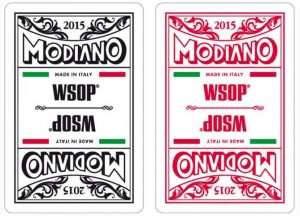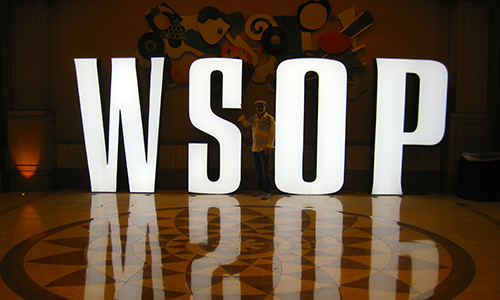Old News is Back Again: the WSOP Cards are Junk
Earlier this week, popular poker pro Doug Polk won the $111,111 One Drop High Roller event at the World Series of Poker, adding another impressive victory to his growing resume. The discovery of an anomaly with many of the cards, though, has emerged as the talk of the tournament, and as the card problems have now been noticed in other events, the WSOP is in the midst of yet another playing card “controversy.”
It was with five players remaining that Doug Polk was allegedly the first to notice something strange with the cards.
“I looked down at my cards and discovered there were white dots at different patterns for each card,” he posted on Twitter.
That immediately made him and others suspicious, as he followed that up with, “The cards at this final table are marked, we are not going to continue until we have a real deck.”
Fourth place finisher and renowned basketball bettor Haralabos Voulgaris also saw the markings, tweeting, “So it seems all the wsop RFID cards are marked. Or at the very least flawed.”
The WSOP said that it was the automatic shuffler that was creating the marks. While nobody at the One Drop High Roller final table has even come close to accusing anyone of trying to cheat, Voulgaris continued on Twitter, saying he doesn’t think that the marks could simply be from shitty card shufflers: “Cards had speckled shiny dots in what appeared to be distinctive patterns based on value of the cards. Was not a function of shuffler imo. Was really spooky, took a few tries until we found decks which did not have the arrangement of dots.”
He and Polk both thought that the markings appeared to be in some sort of pattern, possibly to indicate what was on the face of the card, but neither were able to examine them for long enough to determine anything definitively.
This has also served as a catalyst for player complaints about the cards being used at this year’s World Series of Poker. It seems that everybody is noticing marks on the cards. In general, most people don’t think anyone is actually trying to mark the cards, especially because the problem is occurring all around the poker room.
What people are surmising is that the cards are of such low quality that it is exceedingly easy to accidentally mark the cards by accident. When most people peek at their cards, they do so by handling the cards gently. Not everybody is like that, though. Some squeeze the cards hard. Some really bend them instead of softly curling them. Some dig their finger nails into the cards.
All of these more forceful ways of manipulating cards can result in cards, especially flimsier ones, becoming disfigured in some way. Creases, permanent bends, and pock marks can manifest themselves in quick order.
Mike “The Mouth” Matusow used his virtual mouth via Twitter to criticize the cards, saying, “Cards at WSOP are a total disgrace after 1 round they are all marked. They get them for free & can care less about players.”
Daniel Strelitz, similarly, posted, “Every other hand at this table is a marked card. @wsop this is miserable. Can we get some adequate cards please.”
The WSOP has been willing to replace decks as soon as marks are seen on cards, but officials also stupidly gave everyone warnings that whoever damages a card will receive a penalty. Certainly, adults should know how to handle cards in such a way so as not to damage them, but people are people and have different ways of manipulating cards. In most years, this is not a problem because in most years, the cards aren’t made from shaved tree bark.
WSOP officials have said that the cards are the same as last year’s and that a new shipment arrived this week.
 This is not the first time that there have been card issues at the World Series of Poker. In 2007, then-WSOP commish Jeffrey Pollack lauded the introduction of KEM’s new “Poker Peek” cards, which were designed specifically for use at the poker tables. One big problem: everybody hated them. For example, the sixes and nines were nearly impossible to differentiate without counting pips, resulting in players misreading their hands, and the suit symbols were tiny and thus difficult to read from a distance (remember, poker tables are long). The backs of the cards were also asymmetrical, lending themselves to marking by cheaters. The cards were quickly replaced early on in the 2007 WSOP.
This is not the first time that there have been card issues at the World Series of Poker. In 2007, then-WSOP commish Jeffrey Pollack lauded the introduction of KEM’s new “Poker Peek” cards, which were designed specifically for use at the poker tables. One big problem: everybody hated them. For example, the sixes and nines were nearly impossible to differentiate without counting pips, resulting in players misreading their hands, and the suit symbols were tiny and thus difficult to read from a distance (remember, poker tables are long). The backs of the cards were also asymmetrical, lending themselves to marking by cheaters. The cards were quickly replaced early on in the 2007 WSOP.
For the 2015 WSOP, Italian manufacturer Modiano supplied the cards for the first time. Similar to this year, the cards were too thin and easily marked. In specialty games that focused on low hands, like deuce-to-seven games, this was a specific problem, as low cards were handled more often than high cards. Cards that were handled more often developed marks, creases, and the like, and were therefore easy to identify even when face down.
Advise for future WSOP’s: get the cards ahead of time and test them out to make sure you don’t start the Series with pissed-off players.
(The opinions expressed here are those of the author and do not necessarily represent the opinions of the owners and publishers of Flushdraw.)




















COMMENTS